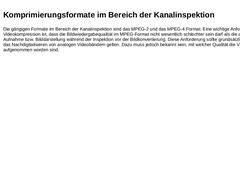
|
Die gängigen Formate im Bereich der Kanalinspektion sind das MPEG-2 und das MPEG-4 Format. Eine wichtige Anforderung an die Videokompression ist, dass die Bildwiedergabequalität im MPEG-Format nicht wesentlich schlechter sein darf als die analoge Aufnahme bzw. Bilddarstellung während der Inspektion vor der Bildkonvertierung. Diese Anforderung sollte grundsätzlich auch für das Nachdigitalisieren von analogen Videobändern gelten. Dazu muss jedoch bekannt … |
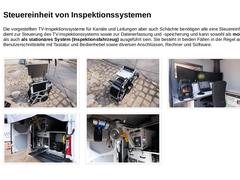
|
Die vorgestellten TV-Inspektionssysteme für Kanäle und Leitungen aber auch Schächte benötigen alle eine Steuereinheit. Diese dient zur Steuerung des TV-Inspektionssystems sowie zur Datenerfassung und -speicherung und kann sowohl als mobiles System als auch als stationäres System (Inspektionsfahrzeug) ausgeführt sein. Sie besteht in beiden Fällen in der Regel aus Monitor, Benutzerschnittstelle mit Tastatur und Bedienhebel sowie diversen Anschlüssen, … |
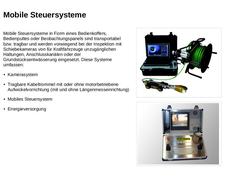
|
Mobile Steuersysteme in Form eines Bedienkoffers, Bedienpultes oder Beobachtungspanels sind transportabel bzw. tragbar und werden vorwiegend bei der Inspektion mit Schiebekameras von für Kraftfahrzeuge unzugänglichen Haltungen, Anschlusskanälen oder der Grundstücksentwässerung eingesetzt. Diese Systeme umfassen: |
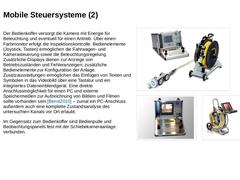
|
Der Bedienkoffer versorgt die Kamera mit Energie für Beleuchtung und eventuell für einen Antrieb. Über einen Farbmonitor erfolgt die Inspektionskontrolle. Bedienelemente (Joystick, Tasten) ermöglichen die Fahrwagen- und Kamerasteuerung sowie die Beleuchtungsregelung. Zusätzliche Displays dienen zur Anzeige von Betriebszuständen und Fehleranzeigen; zusätzliche Bedienelemente zur Konfiguration der Anlage. Zusatzausstattungen ermöglichen das Einfügen … |
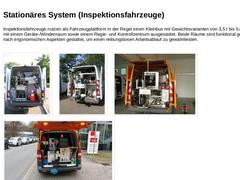
|
Inspektionsfahrzeuge nutzen als Fahrzeugplattform in der Regel einen Kleinbus mit Gewichtsvarianten von 3,5 t bis 5,0 t. Sie sind mit einem Geräte-/Windenraum sowie einem Regie- und Kontrollzentrum ausgestattet. Beide Räume sind funktional getrennt und nach ergonomischen Aspekten gestaltet, um einen reibungslosen Arbeitsablauf zu gewährleisten. (Bild: Inspektionsfahrzeug für die Inspektion von Kanälen und Leitungen der Firma Rico ) (Bild: Inspektionsfahrzeug … |
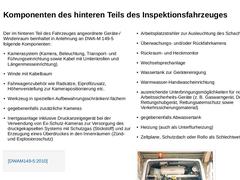
|
Der im hinteren Teil des Fahrzeuges angeordnete Geräte-/Windenraum beinhaltet in Anlehnung an DWA-M 149-5 folgende Komponenten: -
Kamerasystem (Kamera, Beleuchtung, Transport- und Führungseinrichtung sowie Kabel mit Umlenkrollen und Längenmesseinrichtung)
-
Winde mit Kabelbaum
-
Fahrwagenzubehör wie Radsätze, Eiprofilzusatz, Höhenverstellung zur Kamerapositionierung etc.
-
Werkzeug in speziellen Aufbewahrungsschränken/-fächern
-
gegebenenfalls zusätzliche …
|
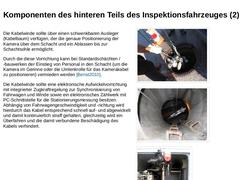
|
Die Kabelwinde sollte über einen schwenkbaren Ausleger (Kabelbaum) verfügen, der die genaue Positionierung der Kamera über dem Schacht und ein Ablassen bis zur Schachtsohle ermöglicht. Durch die diese Vorrichtung kann bei Standardschächten / -bauwerken der Einstieg von Personal in den Schacht (um die Kamera im Gerinne oder die Umlenkrolle für das Kamerakabel zu positionieren) vermieden werden [Benst2010]. Die Kabelwinde sollte eine elektronische Aufwickelvorrichtung … |
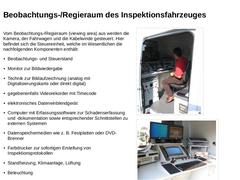
|
Vom Beobachtungs-/Regieraum (viewing area) aus werden die Kamera, der Fahrwagen und die Kabelwinde gesteuert. Hier befindet sich die Steuereinheit, welche im Wesentlichen die nachfolgenden Komponenten enthält: -
Beobachtungs- und Steuerstand
-
Monitor zur Bildwiedergabe
-
Technik zur Bildaufzeichnung (analog mit Digitalisierungskarte oder direkt digital)
-
gegebenenfalls Videorekorder mit Timecode
-
elektronisches Dateneinblendgerät
-
Computer mit Erfassungssoftware …
|
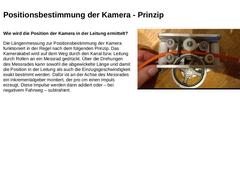
|
Wie wird die Position der Kamera in der Leitung ermittelt? Die Längenmessung zur Positionsbestimmung der Kamera funktioniert in der Regel nach dem folgenden Prinzip. Das Kamerakabel wird auf dem Weg durch den Kanal bzw. Leitung durch Rollen an ein Messrad gedrückt. Über die Drehungen des Messrades kann sowohl die abgewickelte Länge und damit die Position in der Leitung als auch die Einzugsgeschwindigkeit exakt bestimmt werden. Dafür ist an der Achse … |
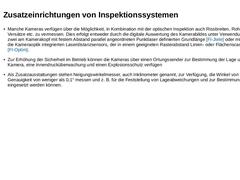
|
-
Manche Kameras verfügen über die Möglichkeit, in Kombination mit der optischen Inspektion auch Rissbreiten, Rohrfugenweiten, Versätze etc. zu vermessen. Dies erfolgt entweder durch die digitale Auswertung des Kamerabildes unter Verwendung einer durch zwei am Kamerakopf mit festem Abstand parallel angeordneten Punktlaser definierten Grundlänge [FI-Jtele] oder mit Hilfe eines in die Kameraoptik integrierten Laserdistanzsensors, der in einem geeigneten …
|

|
Wesentlicher Bestandteil eines TV-Inspektionssystems ist neben der eingesetzten Hardware die entsprechende Software, welche die Bedienung des Systems sowie die Datentransferverarbeitung und -speicherung sicherstellt sowie die zahlreichen Bilddarstellungsmodi mit ihren entsprechenden Zusatzfunktionen ermöglicht. Zentrale Aufgabe ist die individuelle Erfassung und Dokumentation aller relevanten bzw. von der Kamera und den dort oder im Fahrwagen gegebenenfalls … |
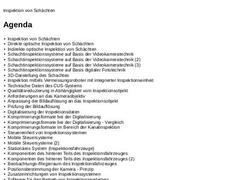
|
|
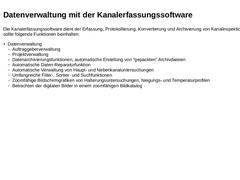
|
Die Kanalerfassungssoftware dient der Erfassung, Protokollierung, Konvertierung und Archivierung von Kanalinspektionsdaten. Sie sollte folgende Funktionen beinhalten: -
Datenverwaltung
-
Auftraggeberverwaltung
-
Projektverwaltung
-
Datenarchivierungsfunktionen, automatische Erstellung von "gepackten" Archivdateien
-
Automatische Daten-Reparaturfunktion
-
Automatische Verwaltung von Haupt- und Nebenkanaluntersuchungen
-
Umfangreiche Filter-, Sortier- und …
|
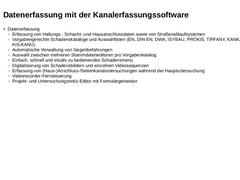
|
-
Datenerfassung
-
Erfassung von Haltungs-, Schacht- und Hausanschlussdaten sowie von Straßenablaufsystemen
-
Vorgabengerechte Schadenskataloge und Auswahllisten (EN, DIN EN, DWA, ISYBAU, PROKIS, TIFFANY, KANKAT, KANDIS, KIS-KANU)
-
Automatische Verwaltung von Gegenbefahrungen
-
Auswahl zwischen mehreren Stammdateneditoren pro Vorgabenkatalog
-
Einfach, schnell und intuitiv zu bedienendes Schadensmenü
-
Digitalisierung von Schadensbildern und einzelnen …
|
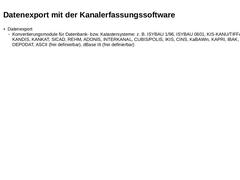
|
-
Datenexport
-
Konvertierungsmodule für Datenbank- bzw. Katastersysteme: z. B. ISYBAU 1/96, ISYBAU 0601, KIS-KANU/TIFFANY, PROKIS, KANDIS, KANKAT, SICAD, REHM, ADONIS, INTERKANAL, CUBIS/POLIS, IKIS, CINS, KaBAWin, KAPRI, IBAK, PoyGIS, VSA, DEPODAT, ASCII (frei definierbar), dBase III (frei definierbar)
|
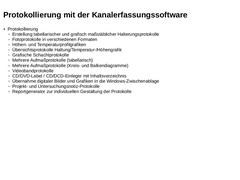
|
-
Protokollierung
-
Erstellung tabellarischer und grafisch maßstäblicher Halterungsprotokolle
-
Fotoprotokolle in verschiedenen Formaten
-
Höhen- und Temperaturprofilgrafiken
-
Übersichtsprotokolle Haltung/Temperatur-/Höhengrafik
-
Grafische Schachtprotokolle
-
Mehrere Aufmaßprotokolle (tabellarisch)
-
Mehrere Aufmaßprotokolle (Kreis- und Balkendiagramme)
-
Videobandprotokolle
-
CD/DVD-Label / CD/DCD-Einleger mit Inhaltsverzeichnis
-
Übernahme digitaler Bilder …
|
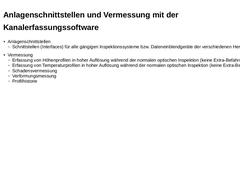
|
-
Anlagenschnittstellen
-
Schnittstellen (Interfaces) für alle gängigen Inspektionssysteme bzw. Dateneinblendgeräte der verschiedenen Hersteller
-
Vermessung
-
Erfassung von Höhenprofilen in hoher Auflösung während der normalen optischen Inspektion (keine Extra-Befahrung)
-
Erfassung von Temperaturprofilen in hoher Auflösung während der normalen optischen Inspektion (keine Extra-Befahrung)
-
Schadensvermessung
-
Verformungsmessung
-
Profilhistorie
|

|
|
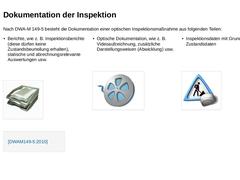
|
Nach DWA-M 149-5 besteht die Dokumentation einer optischen Inspektionsmaßnahme aus folgenden Teilen: -
Berichte, wie z. B. Inspektionsberichte (Hinweis: dürfen keine Zustandsbeurteilung beinhalten),
-
Berichte bezüglich statistischer oder abrechnungsrelevanter Auswertungen (z. B. Tageslisten, Nennweitenlisten etc.)
-
Optische Dokumentation, wie z. B. Videoaufzeichnung, zusätzliche Darstellungsweisen (Abwicklung) usw.
-
Inspektionsdaten mit Grunddaten …
|
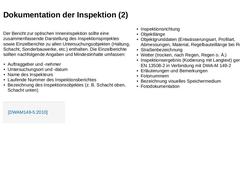
|
Der Bericht zur optischen Inneninspektion sollte eine zusammenfassende Darstellung des Inspektionsprojektes sowie Einzelberichte zu allen Untersuchungsobjekten (Haltung, Schacht, Sonderbauwerke, etc.) enthalten. Die Einzelberichte sollten nachfolgende Angaben und Mindestinhalte umfassen: -
Auftraggeber und -nehmer
-
Untersuchungsort und -datum
-
Name des Inspekteurs
-
Laufende Nummer des Inspektionsberichtes
-
Bezeichnung des Inspektionsobjektes (z. B. …
|
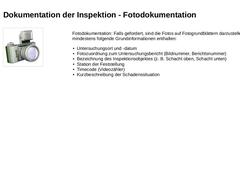
|
(Bild: Picto Foto Images Fotoapparat) Fotodokumentation: Falls gefordert, sind die Fotos auf Fotogrundblättern darzustellen, die mindestens folgende Grundinformationen enthalten: -
Untersuchungsort und -datum
-
Fotozuordnung zum Untersuchungsbericht (Bildnummer, Berichtsnummer)
-
Bezeichnung des Inspektionsobjektes (z. B. Schacht oben, Schacht unten)
-
Station der Feststellung
-
Timecode (Videozähler)
-
Kurzbeschreibung der Schadenssituation
|
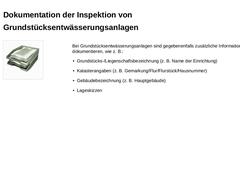
|
(Bild: Picto Desk Storage Schreibtisch Ablage Archiv) Bei Grundstücksentwässerungsanlagen sind gegebenenfalls zusätzliche Informationen zu dokumentieren, wie z. B.: -
Grundstücks-/Liegenschaftsbezeichnung (z. B. Name der Einrichtung)
-
Katasterangaben (z. B. Gemarkung/Flur/Flurstück/Hausnummer)
-
Gebäudebezeichnung (z. B. Hauptgebäude)
-
Lageskizzen
|
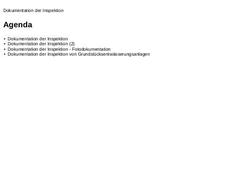
|
|
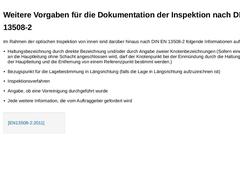
|
Im Rahmen der optischen Inspektion von innen sind darüber hinaus nach DIN EN 13508-2 folgende Informationen aufzuzeichnen: -
Haltungsbezeichnung durch direkte Bezeichnung und/oder durch Angabe zweier Knotenbezeichnungen (Sofern eine Rohrleitung an die Hauptleitung ohne Schacht angeschlossen wird, darf der Knotenpunkt bei der Einmündung durch die Haltungsbezeichnung der Hauptleitung und die Entfernung von einem Referenzpunkt bestimmt werden.)
-
Bezugspunkt …
|
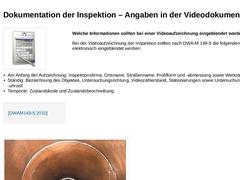
|
Welche Informationen sollten bei einer Videoaufzeichnung eingeblendet werden? Bei der Videoaufzeichnung der Inspektion sollten nach DWA-M 149-5 die folgenden Angaben elektronisch eingeblendet werden: -
Am Anfang der Aufzeichnung: Inspektionsfirma, Ortsname, Straßenname, Profilform und -abmessung sowie Werkstoff
-
Ständig: Bezeichnung des Objektes, Untersuchungsrichtung, Videozählerstand, Stationierungen sowie Untersuchungsdatum und -…
|